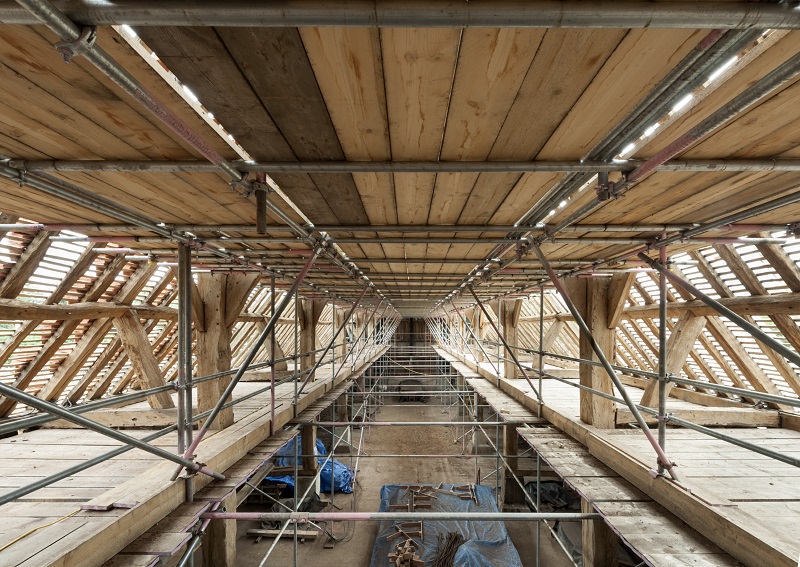Find Reliable Scaffolding Services in Surrey for Your Project Needs
Wiki Article
Checking Out the Various Kinds Of Scaffolding Used in Construction Jobs
The building and construction market relies heavily on different types of scaffolding to meet particular task requirements, each offering distinct benefits and applications. Typical frame scaffolding offers a tough foundation for basic tasks, while put on hold scaffolding is essential for job on high-rise frameworks.
Standard Framework Scaffolding
Standard frame scaffolding is among one of the most commonly made use of approaches in the building and construction market due to its robustness and convenience. This system consists of straight and upright frames that are put together to develop a secure system for workers and products. The main parts consist of upright articles, straight ledgers, and diagonal braces, which together offer a strong structure that can sustain considerable tons.Among the key benefits of standard frame scaffolding is its adaptability to different building tasks, varying from residential structures to big business structures. The modular design permits very easy setting up and disassembly, making it efficient for both short-term and long-term projects. In addition, the system can be tailored in height and size, fitting various structure styles and site conditions.
Security is paramount in scaffolding applications, and conventional frame systems are equipped with guardrails and toe boards to stop falls and guarantee employee defense. Routine examinations and adherence to safety policies are vital in maintaining the honesty of the scaffold (Scaffolding). Generally, traditional framework scaffolding continues to be a basic option in the building sector, offering a trusted platform for labor and enhancing overall project effectiveness

Suspended Scaffolding
Suspended scaffolding offers an unique option for building and construction projects that require accessibility to raised surfaces, specifically in scenarios where traditional structure scaffolding might be unwise. This kind of scaffolding is usually suspended from the roof covering or upper levels of a framework, utilizing a system of systems, ropes, and sheaves to create a working room that can be adjusted to different heights.Among the main advantages of suspended scaffolding is its flexibility. It can be easily rearranged or decreased to fit adjustments in construction requirements, making it optimal for tasks such as window installment, façade work, and upkeep on high-rise structures. In addition, the minimal footprint of suspended scaffolding enables much better use ground area in urban environments, where space is usually limited.
Security is a critical consideration in the usage of put on hold scaffolding. Generally, put on hold scaffolding offers a effective and reliable service for accessing hard-to-reach areas in different construction situations, boosting both productivity and security on site.
System Scaffolding
System scaffolding, usually considered as a modern option in the scaffolding market, contains pre-engineered elements that can be rapidly assembled and adjusted for various construction projects. Scaffolding. This sort of scaffolding is defined by its modular layout, which permits adaptability and performance on job websites, fitting different elevations and architectural needsTypically made from high-strength steel or aluminum, system scaffolding supplies boosted resilience and stability. The parts include upright articles, straight journals, and angled braces, which adjoin firmly, making certain a durable framework. The style often includes standardized fittings, streamlining assembly and disassembly processes, thus minimizing labor time and expenses.

Rolling Scaffolding
Moving scaffolding is a versatile alternative to standard set scaffolding, designed for wheelchair and convenience of use on building and construction sites. This kind of scaffolding includes a platform supported by frames with wheels, permitting employees to conveniently transfer it as required. The mobility attribute substantially boosts efficiency, as it minimizes downtime connected with disassembling and setting up fixed scaffolding.Normally created from lightweight products such as aluminum or steel, rolling scaffolding supplies a sturdy yet portable service for jobs needing regular repositioning - Scaffolding. It is especially beneficial in jobs such as paint, drywall installation, and electric work, where access to various elevations and locations is required
Safety and security is vital in rolling scaffolding layout, with functions such as securing wheels to stop unintentional movement when being used, and guardrails to secure employees from drops. In addition, lots of designs are adjustable in elevation, suiting various task requirements.
Cantilever Scaffolding

The design of cantilever scaffolding typically entails using arms or brackets secured to a building or framework, allowing the platform to extend exterior safely. Security is extremely important; therefore, these scaffolds should be crafted to stand up to ecological conditions and various tons. Routine examination and maintenance are important to make sure architectural integrity and employee safety and security.
Cantilever scaffolding is preferred for its adaptability and effective usage of space, making it a prominent selection in city atmospheres where room restraints prevail. It promotes less complicated accessibility to high altitudes, ultimately adding to the total performance of building projects. Just like all scaffolding kinds, appropriate training and adherence to security standards are essential for employees using cantilever scaffolding.
Conclusion
Traditional structure scaffolding supplies stability, while suspended scaffolding provides adaptability for raised tasks. System scaffolding facilitates fast assembly, and rolling scaffolding improves movement for varying work atmospheres.Standard framework scaffolding gives a strong foundation for basic jobs, while put on hold scaffolding is essential for job on high-rise structures.Rolling scaffolding is a functional option to traditional fixed scaffolding, made for flexibility and simplicity of use on building and construction websites. As with all scaffolding kinds, correct training and adherence to safety criteria are vital for workers utilizing cantilever scaffolding.
Conventional framework scaffolding supplies security, while suspended scaffolding provides convenience for raised jobs. System scaffolding facilitates quick setting up, and rolling scaffolding boosts flexibility for varying job atmospheres.
Report this wiki page